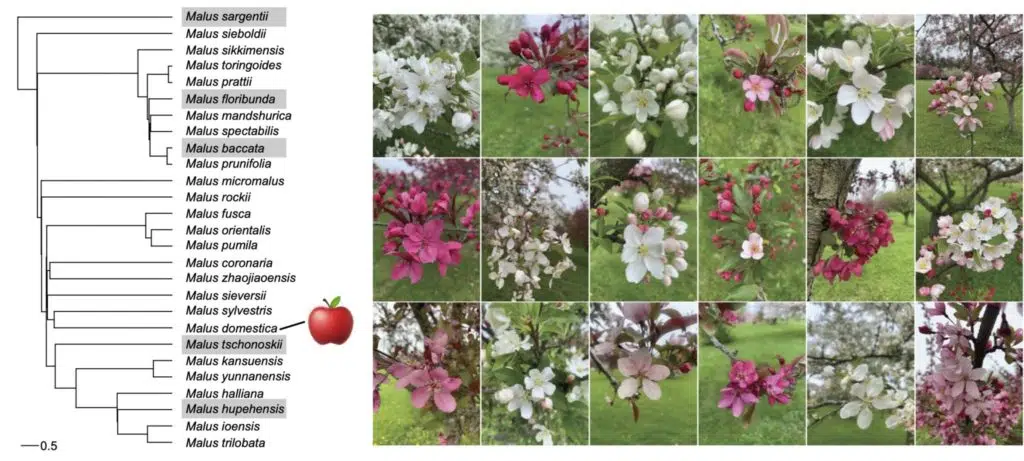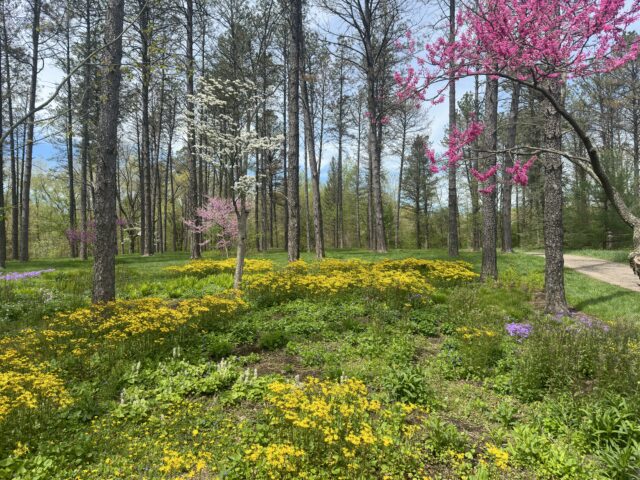
Crabapples, the wild apple species and cultivars (Malus spp.), are important members of the rose family. Crabapples produce profuse blossom (Fig. 1) and small fruits (Fig. 2)1. Many crabapples are cultivated as ornamental trees or rootstocks, and their apples can be used for preserves1. Common crabapples1 (Fig. 1) include the European crabapple (Malus sylvestris), the Caucasian crabapple (Malus orientalis), the Siberian crabapple (Malus baccata), and the crabapples native to North American such as Malus angustifolia, Malus coronaria, Malus ioensis, and Malus fusca.

Fig. 1 Malus species and cultivars. The wild apple species highlighted in grey in the Malus phylogeny (left) are included in the collections at the Holden Arboretum. The ornamental cultivars (right) showcase the floral diversity. Malus domestica is the domesticated apple.

Fig. 2 Crabapples differ dramatically in fruits (size, shape, color). They are much smaller than the domesticated apple.
Evolutionary history. Although we have a relatively clear idea about the evolutionary histories of the wild apple species (Fig. 1), we have little information about the relationships of these cultivars that are widely planted as ornamental trees in yards, gardens, arboreta, and urban landscape. These crabapple cultivars have been derived from the wild apple species by crossing between different plants or other methods (e.g. from open-pollinated seeds). Yet, the genetic ancestries of these cultivars and their relationships to wild apple species remain an unsolved mystery. One line of our research at Holden is to disentangle the genetic ancestries of the crabapple cultivars in relation to wild species by sequencing their genomes. These genomes will also provide insights into human selection for floral traits, stress tolerance, and disease resistance.
Microbiome. Plants are smart to outsource essential plant functions to microbial partners both belowground and aboveground associated with leaves and flowers. Maintaining a healthy microbiome is thus important for plant health. Our first step is to figure out what microbes are living in crabapple leaves and flowers. To do this, we are using both sequencing and microbe culturing approaches.
The second step is to figure out what factors determine leaf and flower microbiomes. Do closely related crabapples share similar leaf and flower microbiomes? How do ecophysiological and morphological traits shape leaf microbiome? How do pollinators contribute to flower microbiome? Do resistant cultivars differ from susceptible cultivars in leaf and flower microbiomes?
The last step is to figure out the functions of leaf and flower microbiomes. Can microbiomes of resistant cultivars be used to benefit susceptible cultivars? To study this, we are cultivating sterile clonal plants and will inoculate these sterile plants with microbes to specifically test the functions of these microbes in promoting disease resistant and plant health in general.
References
1 Cornille, A., Giraud, T., Smulders, M. J., Roldan-Ruiz, I. & Gladieux, P. The domestication and evolutionary ecology of apples. Trends Genet 30, 57-65 (2014).

Dr. Na Wei
Scientist
Na is a Research Scientist at Holden Arboretum. She is an evolutionary ecologist and geneticist. Her research program seeks to elucidate the ecological and evolutionary mechanisms that confer or constrain plant adaptation to environmental change.











